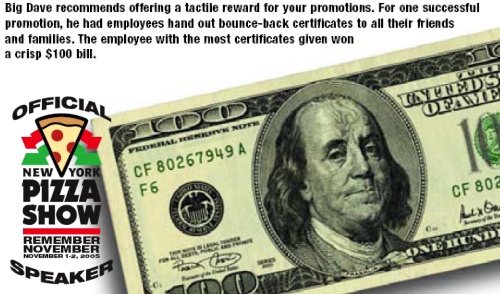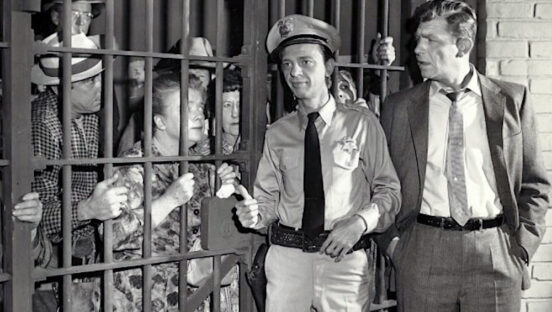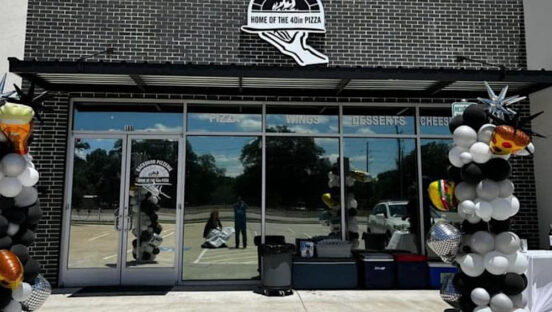Every year the cost of doing business goes up. Every year you lose customers. Every year you need to create a marketing plan that adds to your customer base and increases your gross sales and net profit. This year is no different.

Here are the steps for launching a successful promotion. After you've decided on the strategy and promotion you're going to use, it's a good idea to print out a calendar and place the small steps on it. I always try to visualize the promotion with the end in mind. What is the end goal? Why am I dong this? What is the timeline I'm working with? Will I need to hold an employee briefing to explain the promotion? For an example, I'm going to highlight a strategy I used many times. I call it Employee Bounce Back Certificates.
I chose this old reliable because it always brought in a lot of new customers and the investment was very low.
My goal was to increase sales $100,000 over the previous year's sales. I set this goal to offset new government laws that would seriously put a crimp on my income and lifestyle. The timeline was aggressive. I wanted to gain – no, steal – several hundred of my competitor's regular customers.
The first step is to design and order any printed material you'll need. Working closely with a speedy print shop or designing it on your computer can save a lot of money and time. In this case I needed several hundred printed cards. I designed them and had my printer run them.
Since this promotion would be executed primarily by my staff, I needed to call a meeting to explain how the strategy worked. I held monthly staff meetings on the first Saturday of each month, 10 a.m. Be there or be square. I created handouts for all of my employees that explained how the promotion worked with the rules. Printing up a one or two paragraph explanation of the promotion eliminates a lot of questions and you'll run a consistent promo.
This promotion had a grand prize of a $100 bill. Have one of those. You are much more likely to have an emotional buy-in when they can see, feel and touch the pieces of the puzzle.
Rehearsing the presentation to your staff is next. I never deliver a presentation before I rehearse it a few times in front of a mirror and anticipate all of the questions I might answer. The best lawyers in the world never ask a question they don't have an answer for. During this preparation time, you'll discover the message you want to deliver has a few holes in it. This is the time to fill the holes with thought out responses in advance of the questions that are likely to follow.
Now, comes the execution and implementation part. The company wide meeting has started. Your staff has gathered and you explain the goals and objectives of the upcoming promotion. They get the handout and follow along as you explain how you want it to go. They ask a few questions. You have your answers ready. Then you hand out any printed pieces that you'll be using. You then may want to do a role-play. One employee plays a customer and another plays order taker in front of the group. They practice until they give the right responses and can control the dialog. You are the movie director. When and if they stumble you say, "cut" and demonstrate the right way to play out the scene.
Almost every great promotion ever implemented was turned into an employee contest. This particular one was designed to gain and track new customers for a month. The employee that had the most bounce back certificates redeemed won a crisp $100 dollar bill. I also provided for additional spiffs of $20 to weekly leaders. This works wonders in getting emotional buy in. Otherwise the crew thinks, "This is one more thing the boss want me to do." Rather than, "All I have to do is give away cards to my friends and maybe I'll win the $100."
Once the promotion is launched you need to develop a measurement tool to quantify the results. Promotions must be measured to determine if they were brilliant or a dud. Hard data is necessary to make that call. Otherwise you'll never be able to quantify and justify the marketing money you'll be spending. By tracking the results you'll know for sure what the ROI (return on investment) was.
Finally, you must analyze the promotion when it has finished. During this step you'll know if it was successful and how much it cost, and how much it brought in. You'll also learn how to improve it if you run it again. Gather all of the data and put it in a three ring binder so it will be available the next time you need it.
These are the steps of what goes on behind the scenes before, during and after a marketing program is implemented. Some of your plans will be brilliant and some will be so-so. By practicing these accountabilities and tracking marketing promotions, you'll get to be a master Pizza Guerilla Marketer.
To read all about this promotion go to https://www.pmq.com/bigdave_spring98.shtml and see how I turned $400 into $90,000. Darn, I missed my goal by a little, but still received a 248:1 return on investment. So can you.













